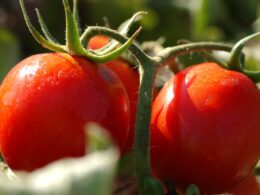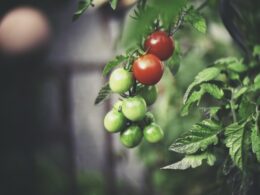Are you tired of waiting for your tomato plants to bear fruit? Don’t worry, you’re not alone. Many gardeners eagerly anticipate the day they can finally harvest sun-ripened tomatoes from their backyard. However, sometimes it feels like that day may never come.
In this article, we’ll provide you with some simple yet effective techniques to speed up the fruiting process of your tomato plants so that you can enjoy fresh, juicy tomatoes sooner. Follow these tried and tested methods to ensure a faster and healthier harvest while also keeping your precious plants safe from potential threats.
Whether you’re an experienced gardener or just starting out, implementing these strategies will help improve your overall gardening experience by providing optimal conditions for your tomatoes to thrive in. Relax knowing that your hard work will pay off sooner than expected as you watch those green fruits transform into delicious red treasures right before your eyes!
Choose the Right Tomato Varieties
Picking the perfect tomato varieties can significantly impact how quickly they’ll produce those juicy, delicious fruits we all love. Some types of tomatoes are naturally faster producers than others, so it’s important to keep that in mind when selecting your plants.
By choosing early-season or fast-maturing varieties, you’ll be well on your way to enjoying a bountiful harvest sooner rather than later. When searching for quick-fruiting tomato plants, look for ones labeled as ‘early’ or ‘fast maturing.’ These types of tomatoes have been bred specifically to produce fruit in less time.
A few popular choices include Early Girl, Stupice, and Sub Arctic Plenty – all known for their speedy growth and production rates. Additionally, cherry tomatoes tend to ripen faster than larger varieties like beefsteak tomatoes, making them another great option if you’re looking for a quicker harvest.
To further speed up the process and ensure an abundant harvest, consider planting more than one variety of early-season tomato plant in your garden. Mixing different types will not only provide aesthetic appeal but also increase the likelihood that at least some of your plants will thrive under various conditions.
With these tips in mind, you’ll be well on your way to enjoying fresh homegrown tomatoes in no time!
Provide Optimal Growing Conditions
Let’s dive into creating the perfect environment for those tasty tomatoes to flourish and fruit faster! To speed up tomato fruiting, you’ll want to provide optimal growing conditions.
This includes ensuring your tomato plants get enough sunlight, water, and nutrients. Aim for at least six hours of direct sunlight daily – the more sun exposure, the better! Consistent watering is also essential; keep the soil slightly moist but not soggy, as overwatering can lead to root rot or other issues.
When it comes to nutrients, tomatoes are heavy feeders and require a well-balanced fertilizer. Look for a fertilizer specifically formulated for tomatoes with an N-P-K ratio (nitrogen-phosphorus-potassium) that supports both foliage and fruit development. Typically, a ratio of 5-10-5 works well for most tomato varieties. Apply the fertilizer according to package directions throughout the growing season to ensure your plants have all they need to produce healthy fruits quickly.
Another important factor in speeding up tomato fruiting is temperature control. Tomatoes thrive in warm temperatures between 70°F and 85°F during daytime and around 60°F – 65°F at night. If temperatures dip below these ranges or soar too high consistently, it can slow down fruit production or even cause blossoms to drop off before setting fruit. Protect your plants from extreme heat by using shade cloth when necessary or moving potted plants indoors on particularly hot days.
By maintaining ideal growing conditions – adequate sunlight, water, nutrients, and appropriate temperatures – you’re paving the way for quicker tomato harvests while keeping your garden safe and thriving!
Pruning and Training Techniques
Now that we’ve covered optimal growing conditions, let’s dive into pruning and training techniques to further enhance your tomato plants’ productivity! Proper pruning and training not only help speed up fruiting but also promote healthier plants and better airflow, reducing the risk of diseases. By following these simple yet effective methods, you’ll be on your way to a bountiful harvest in no time.
-
Remove suckers: Suckers are small shoots that grow between the main stem and leaf branches. They can divert energy from fruit production, so it’s best to remove them early on. Pinch or snip off suckers when they’re still small, leaving just the main stem and primary branches.
-
Support your plants: Providing support through stakes or cages helps keep your tomato plants upright, allowing for better air circulation and easier access to sunlight. This means more energy focused on producing delicious fruits rather than fighting gravity!
-
Prune lower leaves: As the plant grows taller, remove any yellowing or diseased leaves near the base of the plant. This will help prevent soil-borne diseases from splashing onto foliage during watering while encouraging growth at the top of the plant where flowers and fruits form.
By incorporating these pruning and training techniques into your gardening routine, you’ll not only expedite fruit production but also create an environment where your tomato plants can thrive without feeling stressed by disease or competition for resources. Remember that a healthy plant is a happy plant – one that yields plenty of tasty tomatoes for you to enjoy throughout the season! So go ahead and give these methods a try; after all, who doesn’t want their tomatoes faster?
Encourage Pollination
Ready to boost your tomato plants’ productivity even more? Encouraging pollination is the key, and we’ve got some tips to help you out!
Pollination is essential for fruit production in tomatoes. It’s the process by which pollen from a flower’s male reproductive organs (the stamens) is transferred to the female reproductive organs (the pistil), resulting in fertilization and fruit development.
While tomatoes are self-pollinating, meaning they don’t require another plant for successful pollination, there are still steps you can take to lend nature a helping hand. First, give your plants a gentle shake every day or two. This mimics the vibrations created by wind or bees buzzing around the flowers and helps release pollen from the anthers onto the stigma.
You’ll want to do this during warmer parts of the day when humidity levels are lower, as high humidity can make pollen sticky and less likely to disperse. Alternatively, use an electric toothbrush or battery-operated fan near the base of your plants while they’re flowering – these work wonders at dispersing pollen too!
Another way to encourage pollination is by attracting beneficial insects like bees and butterflies into your garden. Planting nectar-rich flowers such as marigolds, zinnias, sunflowers and lavender nearby will draw these pollinators in, increasing their chances of visiting your tomato blossoms as well! Additionally, reducing pesticide use will also help create a safer environment for these helpful little creatures.
Give these tips a try and watch as your tomato plants reward you with an abundance of delicious fruits!
Will Speeding Up Tomato Fruiting Affect the Taste of the Tomatoes?
When it comes to growing the tastiest tomatoes, speeding up tomato fruiting may actually affect the taste of the tomatoes. By rushing the fruiting process, the tomatoes may not have enough time to develop their full flavor potential. It’s important to allow the tomatoes to ripen naturally for the best taste.
Monitor and Maintain Plant Health
It’s crucial to keep an eye on your plants’ health and address any issues promptly for a bountiful harvest. Healthy tomato plants are more likely to produce fruit faster, so monitoring their overall wellbeing is essential.
By regularly inspecting your tomato plants, you can quickly identify and treat common problems, such as pests or diseases, before they escalate. Here are some things you can do:
- Keep an eye out for signs of nutrient deficiencies, such as yellowing leaves or stunted growth. Make sure you provide your plants with a balanced fertilizer that contains all the necessary nutrients.
- Watch for pests like aphids, whiteflies, and hornworms that can cause damage to your tomato plants. If you notice any infestations, try using organic pest control methods like introducing beneficial insects or applying insecticidal soap.
- Inspect your tomatoes regularly for diseases such as blight or wilt and remove affected plant material immediately to prevent the spread of infection.
- Ensure proper airflow around your tomato plants by pruning excess foliage and providing adequate spacing between them. This helps prevent fungal infections and promotes healthy growth.
By being proactive in maintaining plant health, you’re creating an environment that encourages rapid fruiting in your tomatoes. This includes keeping the soil well-draining yet moist enough to support root development while also ensuring sunlight reaches all parts of the plant for optimal photosynthesis.
Remember that a healthy tomato plant is better equipped to produce fruit quickly than one struggling with deficiencies or battling pests, so be diligent about maintaining its wellbeing throughout the growing season!
Conclusion
So, you’ve done your best to speed up tomato fruiting. By choosing the right varieties, providing optimal growing conditions, pruning, and training your plants, and encouraging pollination, you’re well on your way to enjoying a bountiful harvest.
Just remember, patience is key when it comes to growing tomatoes. Keep up the good work, and soon enough, you’ll be enjoying those juicy fruits of your labor.









